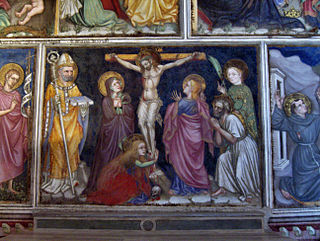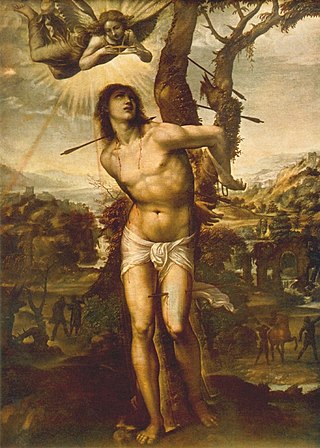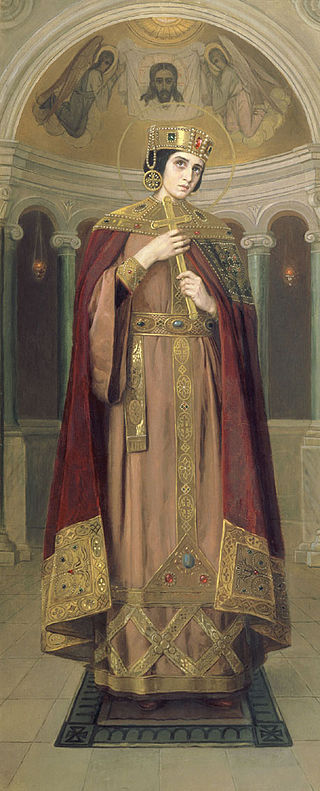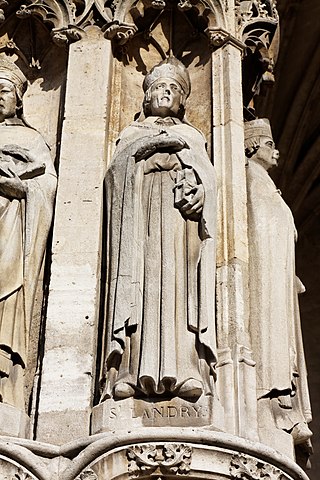
Saint George, also George of Lydda, was a Christian who is venerated as a saint in Christianity. According to tradition, he was a soldier in the Roman army. He was of Cappadocian Greek origin and a member of the Praetorian Guard for Roman emperor Diocletian, but was sentenced to death for refusing to recant his Christian faith. He became one of the most venerated saints and megalomartyrs in Christianity, and he has been especially venerated as a military saint since the Crusades. He is respected by Christians, Druze, as well as some Muslims as a martyr of monotheistic faith.

Jacobus de Voragine was an Italian chronicler and archbishop of Genoa. He was the author, or more accurately the compiler, of the Golden Legend, a collection of the legendary lives of the greater saints of the medieval church that was one of the most popular religious works of the Middle Ages.

Saint Valentine was a 3rd-century Roman saint, commemorated in Western Christianity on February 14 and in Eastern Orthodoxy on July 6. From the High Middle Ages, his Saints' Day has been associated with a tradition of courtly love. He is also a patron saint of Terni, epilepsy and beekeepers. Saint Valentine was a clergyman – either a priest or a bishop – in the Roman Empire who ministered to persecuted Christians. He was martyred and his body buried on the Via Flaminia on February 14, which has been observed as the Feast of Saint Valentine since at least the eighth century.

Margaret, known as Margaret of Antioch in the West, and as Saint Marina the Great Martyr in the East, is celebrated as a saint on 20 July in Western Christianity, on 30th of July by the Eastern Orthodox Church, and on Epip 23 and Hathor 23 in the Coptic Orthodox Church.

The Golden Legend is a collection of 153 hagiographies by Jacobus de Voragine that was widely read in Europe during the Late Middle Ages. More than a thousand manuscripts of the text have survived. It was likely compiled around 1259–1266, although the text was added to over the centuries.

Sebastian was an early Christian saint and martyr. According to traditional belief, he was killed during the Diocletianic Persecution of Christians. He was initially tied to a post or tree and shot with arrows, though this did not kill him. He was, according to tradition, rescued and healed by Irene of Rome, which became a popular subject in 17th-century painting. In all versions of the story, shortly after his recovery he went to Diocletian to warn him about his sins, and as a result was clubbed to death. He is venerated in the Catholic Church and the Orthodox Church.

Lucia of Syracuse (283–304), also called Saint Lucia was a Roman Christian martyr who died during the Diocletianic Persecution. She is venerated as a saint in Catholic, Anglican, Lutheran, and Eastern Orthodox Christianity. She is one of eight women explicitly commemorated by Catholics in the Canon of the Mass. Her traditional feast day, known in Europe as Saint Lucy's Day, is observed by Western Christians on 13 December. Lucia of Syracuse was honored in the Middle Ages and remained a well-known saint in early modern England. She is one of the best known virgin martyrs, along with Agatha of Sicily, Agnes of Rome, Cecilia of Rome and Catherine of Alexandria.

Erasmus of Formia, also known as Saint Elmo, was a Christian saint and martyr. He is venerated as the patron saint of sailors and abdominal pain. Erasmus or Elmo is also one of the Fourteen Holy Helpers, saintly figures of Christian religion who are venerated especially as intercessors.

Agathaof Sicily is a Christian saint. Her feast is on 5 February. Agatha was born in Catania, part of the Roman Province of Sicily, and was martyred c. 251. She is one of several virgin martyrs who are commemorated by name in the Canon of the Mass.

Jude was one of the Twelve Apostles of Jesus according to the New Testament. He is generally identified as Thaddeus and is also variously called Judas Thaddaeus, Jude Thaddaeus, Jude of James, or Lebbaeus. He is sometimes identified with Jude, the brother of Jesus, but is clearly distinguished from Judas Iscariot, the disciple who betrayed Jesus prior to his crucifixion. Catholic writer Michal Hunt suggests that Judas Thaddaeus became known as Jude after early translators of the New Testament from Greek into English sought to distinguish him from Judas Iscariot and subsequently abbreviated his forename. Most versions of the New Testament in languages other than English and French refer to Judas and Jude by the same name.

Senglea, also known by its title Città Invicta, is a fortified city in the South Eastern Region of Malta. It is one of the Three Cities in the Grand Harbour area, the other two being Cospicua and Vittoriosa, and has a population of approximately 2,720 people. The city's title Città Invicta was given because it managed to resist the Ottoman invasion at the Great Siege of Malta in 1565. The name Senglea comes from the Grand Master who built it Claude de la Sengle and gave the city a part of his name. While Senglea is the 52nd most populated locality on the island, due to its incredibly small land area, it is the 2nd most densely populated locality after Sliema.
Three Tales is a work by Gustave Flaubert that was originally published in French in 1877. It consists of the short stories: "A Simple Heart", "Saint Julian the Hospitalier", and "Hérodias".

The Nativity of the Blessed Virgin Mary, the Nativity of Mary, Marymas or the Birth of the Virgin Mary, refers to a Christian feast day celebrating the birth of Mary, mother of Jesus.

Alexandra of Rome was a reputed Christian martyr and saint, known from Martyrdom of Saint George as either Emperor Diocletian's wife or the wife of Dacian, a Roman Prefect. She is also sometimes mistaken with Priscilla or Prisca.

Saint Julian of Le Mans is a saint venerated in both the Roman Catholic and Orthodox Church, honoured as the first bishop of Le Mans. His feast day is 27 January. The translation of his relics is celebrated on 25 July.

Saint Landry or Landericus of Paris was a bishop of Paris and is recognized as a saint by the Roman Catholic Church. Landry built a hospital dedicated to St. Christopher, which later became the Hôtel-Dieu de Paris. His feast day is 10 June.

In the small Mediterranean island nation of Malta the predominant religion is Roman Catholicism.

The Church of St. Julian of the Flemings is a Roman Catholic church dedicated to Saint Julian the Hospitaller, located in Rome, Italy. Historically, the church has been the National Church in Rome of the Southern Netherlands and, in 1830, became the national church of the Kingdom of Belgium.

The Scuola di San Giorgio degli Schiavoni in Venice, northern Italy, was one of the city's confraternities, a scuola piccola located in the sestiere (neighborhood) of Castello, Venice. Its building has been preserved.

The legend of Saint Andrew in Romania tells that today's territory of Romania was Christianized by Saint Andrew in the 1st century AD. While these claims lack any historical and archeological evidence, the legend has been embraced as fact by both the Romanian Orthodox Church and the Romanian state, both during Ceaușescu's protochronism period and after 1989, when Saint Andrew was named the patron saint of Romania.























